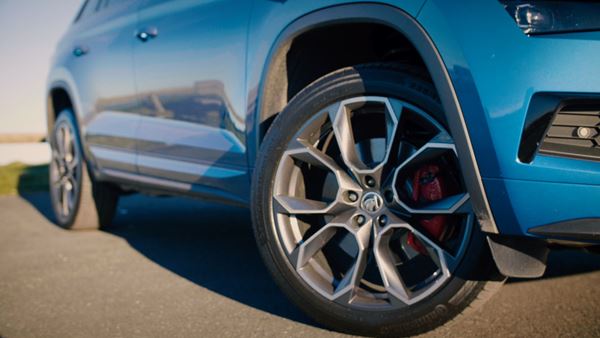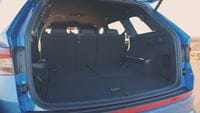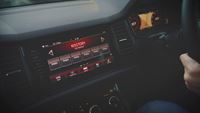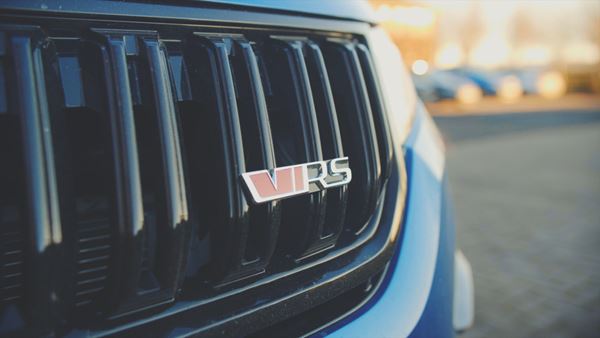Since Skoda dropped the Fabia vRS a few years back, the Octavia has been the only model to bear its performance badge.
Now, though, they’ve got their range-topping SUV in on it and come up with the Kodiaq vRS.
UK orders mightn’t turn up until Spring but there a handful of demo cars knocking about already, and I took one out on the road for a few hours.
It’s not too unlike previous models, but still looks cracking
At a glance there aren’t any massive changes from the Kodiaq Sportline – the vRS’ predecessor – but enough to set it apart.
Both have upgraded bumpers and 20-inch alloys, but the vRS’ ‘Xtreme’ rims look even more imposing and sit above red brake callipers. They’re a handsome set.
Round the back are the squared exhaust tips and full-width reflector that Skoda puts on all its performance models.
It also has the spec-specific badging, front and back, along with gloss-black grille and window surrounds. Our tester was finished in metallic Race Blue and looked cracking.
Inside, it shares the Sportline’s excellent 9.2-inch touchscreen and cushy Alcantara sports seats, with added vRS badging and red stitching that are both unique to this model.
Let’s have a nosey at the numbers
The vRS might impress on looks but if it’s going to wear that badge it’ll have to do well on the move too.
It’s got just under 240bhp, about 50 more than the Sportline’s most powerful engine, that comes from a 2.0-litre twin turbo.

Alongside the 400bhp-plus super SUVs it isn’t a huge power count, but it isn’t pretending to challenge the likes of those.
It’ll go from a standstill to 60mph in seven seconds – an impressive time for anything limited to four cylinders and two litres, but even more so for something this size and diesel-powered.
Which is surprising, considering performance-spec motors tend to come with petrol-only engine choices, or petrol and diesel.
Stats aside, what’s it like to drive?
I took the Kodiaq vRS to the Northumberland coast, easily some of the North East’s best roads, and resisted the urge to drop it into ‘Sport’ mode for all of eight minutes. Even when keeping to the speed limits and general rules of the road, it’d be a bit of a waste not to use it.
The suspension stiffened, and the exhausts’ warble kicked up a level. It felt just as brisk as the numbers suggested, climbing the inclines and rounding the bends with little in the way of delay, or to quote the video review above, like a plastic bag in the wind.
Fitted with Skoda’s seven-speed automatic gearbox and four-wheel drive, as standard, it has a more focused setup than the Sportline – up to 85% of the engine’s output can be sent to any one of the wheels.
The vRS feels confident on the road and holds its stance with impressive body control, especially in Sport.
The steering is a tad light, but it does well to hold the car on the line you’ve put it without swaying about like a loaded trolley turning down the fruit and veg isle at full tilt.



If you want quick, but obedient you’ll be a fan. If you’re after something a bit more involving, that’s just as keen to go sideways as it is forwards, it might not appeal.
This, however, is a car that’s big on flair and usability.
The other side of the coin
After half an hour or so of charging up the coast, I tried a few of the other modes on the Dynamic Chassis Control – yet another bit of standard tech.
Sliding into ‘Comfort’, the suspension lightens and becomes a lot more comfortable on uneven roads. And that’s despite riding on huge, low-profile tyres.
The exhausts also settle down, thanks to the ‘Dynamic Sound Actuator’. It emits an artificial sound from the exhausts to make the diesel twin turbo sound more like a petrol, and varies the volume depending on driving mode.
In Sport, there’s no disguising the diesel’s grunt from inside but it really doesn’t sound too bad outside the car.
Another handy feature is the Virtual Cockpit – replacing the dials behind the steering wheel with a customisable display. I won’t bore you with the different layouts, but one sticks out.
In this arrangement, the rev counter and speedo sit either side of the display, with a small satnav window in between.
I had a larger, north-oriented map open on the huge touchscreen as an overview of my route, while the Virtual Cockpit displayed a close-up of my current location and direction.
Especially handy if you’re driving an unfamiliar route.
It has seven seats, by the way
Although taller passengers might have a task getting into the two rear seats, the kids will have no bother scaling the middle row.
The vRS actually has the Nurburgring’s lap record for a seven-seater SUV, so you can take the whole family out for a jaunt.

And if grandma decides to stay home to watch Vera, the additional seats drop for huge boot space. That boot, by the way, can be opened using a button on the keys or a latch by the driver’s seat.
Granted, it might be expensive at £42k, but the Kodiaq vRS has no direct rival.
The closest is probably the Cupra Ateca – the fast SUV from Seat’s new performance brand – which is quicker and cheaper. But, even then it won’t beat the Kodiaq on fuel economy or number of seats.
And there are only 300 models coming to the UK, so there’s no doubt it’ll stand out. The Kodiaq vRS is a well-kitted and pacey SUV, that also doubles as a more-than-capable family wagon.
If you can get around the pricing, and you’re lucky enough to get a hold of one, you’ll probably have a fair bit of fun owning it.
Find more video reviews on our YouTube channel, LookersWebTV, as part of The Shortcut – our no-nonsense review series. You can also find the latest offers on the vRS here.
The standard Kodiaq is also available on the Lookers Skoda Motability Scheme.

